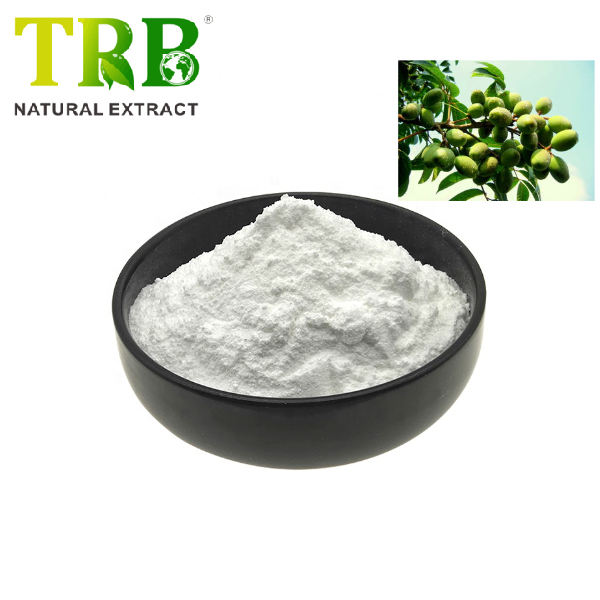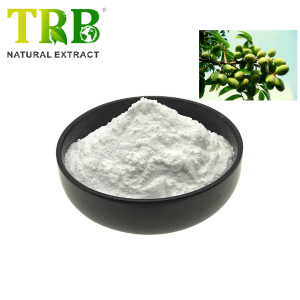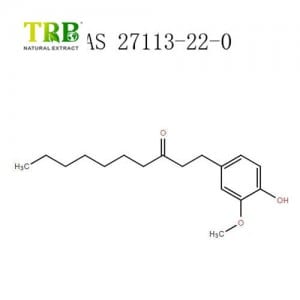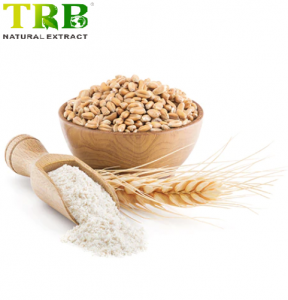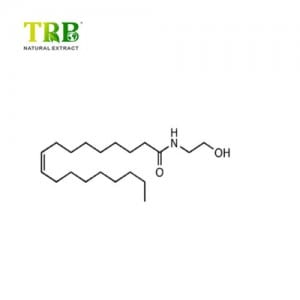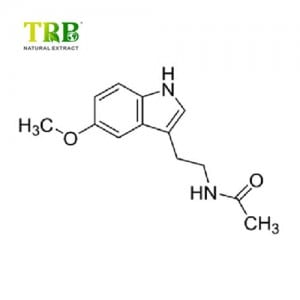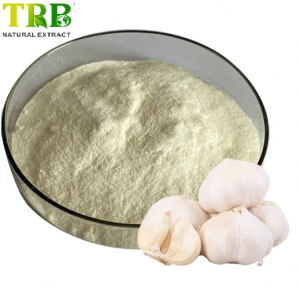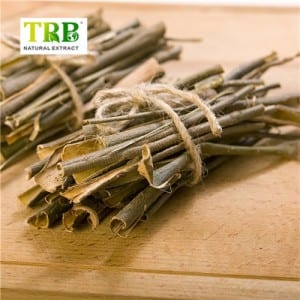Oleanolic asid ki se yon twa pentacyclic triterpenoids izole nan plant Gentianaceae nan Swertia mileensis zèb la antye oswa fwi privet, ak yon kò gratis ak glikozid nan anpil plant.Oleanolic asid gen yon pakèt domèn nan plant, ak kontni an mwayèn se 0.2% - 2%.Cucurbitaceae kontni segondè se 1.5% ~ bosu anba 2%, kontni fwi privet nan 0.6% ~ 0.7%. Oleanolic asid se yon kalite konpoze triterpenoid pentacyclic izole nan fwi a nan genus Asteraceae, Syzygium sylvestris, oswa Ligustrum lucidum.Li se yon adjuvant maladi fwa ak klinikman itilize pou enfeksyon terapetik.Epatit lajònis egi gen efè evidan sou diminye alanin aminotransferase ak jòn.Oolic asid se yon triterpenoids pentacyclic izole nan fwi a nan swertia chinensis oswa fructus ligustris soti nan plant la gentianaceae.Asid oleanolik yo jwenn lajman nan plant yo, ak yon kontni jeneral nan 0.2% ~ 2% [1].Kontni anba a nan kalabas te 1.5% ~ 2%, ak kontni an nan fwi nan fructus ligustris te 0.6% ~ 0.7%.Oleanolic asid se kristal blan acicular (etanòl), san odè ak san gou.Enstab nan asid ak baz.Pwen k ap fonn nan 308 ~ 310 ℃, [alfa] 20 d + 73.3 ° (c = 0.15, klowofòn, ensolubl nan dlo, idrosolubl nan metanol, etanòl, etè etilik, asetòn ak klowofòm.Oleanolic asid se yon triterpenoid ki rive natirèlman, lajman distribiye. nan manje ak plant medsin, ki gen rapò ak asid betulinik Li ka jwenn nan Phytolacca americana (pokeweed Ameriken), ak Syzygium spp, lay, elatriye.
Yo te jwenn asid oleanolik pou montre gwo aktivite anti-VIH, yo te itilize asid betulinik konpoze ki gen rapò pou kreye premye dwòg inhibitor spirasyon komèsyal la.Li te premye etidye ak izole nan plizyè plant, ki gen ladan Rosa woodsii (fèy), Prosopis glandulosa (fèy ak brendiy), Phordendron juniperinum (plant antye), Syzygium claviflorum (fèy), Hyptis capitata (plant antye), ak Ternstromia gymnanthera (ayeryen). pati).Lòt espès Syzygium ki gen ladan java pòm (Syzygium samarangense) ak pòm rose genyen li.
Non pwodwi: Oleanolic asid98%
Spesifikasyon: 98% pa HPLC
Sous Botanik: Ekstrè Olea Europea
Non chimik: (3β)-3-Hydroxyolean-12-en-28-oic asid
Nimewo CAS:508-02-1
Pati ki itilize: fèy
Koulè: poud blan ak odè karakteristik ak gou
Estati GMO: GMO gratis
Anbalaj: nan tanbou fib 25kgs
Depo: Kenbe veso ki pa louvri nan yon kote ki fre, sèk, Kenbe lwen limyè fò
Lavi etajè: 24 mwa apati dat pwodiksyon an
Ki sa kiasid oleanolik?
Asid oleanolik (OA), yon asid triterpenoid pentacyclic idroksilik natirèl (HPTA) ki sanble ak asid betulinik, asid ursolik;li gen benefis tankou anti-bakteri, anti-enflamatwa, aktivite antitumoral.

Ki kote ou ka jwennasid oleanolik?
Asid oleanolik te itilize tradisyonèlman pou tretman divès maladi, ou ka jwenn li nan manje ak plant lajman.
Gen kèk fwi tankou pòm, grenad, sitwon, bilberries, oliv gen asid oleanolik tou.

| Non zèb | Kontni asid oleanolik | Metòd tès la |
| Ligustrum lucidum Ait | 0.8028% | HPLC |
| Verbena Officinalis L | 0.071%-0.086% | HPLC |
| Prunella vulgaris L | 3.47% -4.46% | HPLC |
| Hemsley Chinensis Cogn. | 1.5% ~ 2% | HPLC |
Kounye a, Chinwa zèbHemsley Chinensis Cogntoujou se materyèl ki pi komèsyal anvan tout koreksyon pou èkstraksyon asid oleanolik.
Hemsley Chinensis Cogn.Entwodiksyon
Hemsleya chinensis Cogn.se yon zèb k ap grenpe kontinuèl, tou se medikaman tradisyonèl Chinwa.
Fanmi: Cucurbitaceae
Tribus: Gomphogyneae
Genus: Hemsleya
Espès: H. amabilis
Zèb la distribye nan pwovens Guangxi, Sichuan, Guizhou, Yunnan, Hubei, elatriye Li te fèt nan kwen an forè ak touf fon nan yon altitid de apeprè 2,000 mèt.
Engredyan aktif: gen Hemslolide Mal、Ma3、H1;Chikusetsusaponin-Iva;dihydro cucurbitacin F-25-acetate;dilydrocucurbitacin F;asid oleanolik-beta-Hlucosyloleanolate;Hemsamabilinin A;Cu-curbitacinⅡb-2-beta-D-glucopyranoside.
Valè medsin:
Hemsleya chinensis Cogn.se sitou pou dezentoksikasyon, esterilizasyon, anti-enflamatwa, ranfòse vant lan ak soulaje doulè.Kounye a, gen ekstrè poud, oswa preparasyon konpoze tankou kapsil, tablèt, grenn gastwoentestinal, elatriye, ki lajman ki itilize nan pratik klinik.

Ekstraksyon nan asid oleanolik soti nanHemsleya Chinensis Cogn.

Fòmil ki gen asid oleanolik nan sipleman Manje
Nou te jwenn ke asid oleanolik yo itilize nan sipleman sante sitou soti nan twa kalite ekstrè plant: ekstrè fèy Loquat, ekstrè Hemsley Chinensis, ak ekstrè Basil apa pou Bondye.
- Sentespri Basil poud (fèy) (0.4% asid ursolik ak asid oleanolik, 2.0 mg)
- Holy Basil supercritical CO2 ekstrè (fèy) (Ocimum tenuiflorum Linn.) (2.5% asid ursolik ak asid oleanolik, 1.5 mg)
- Ekstrè Loquat (fwi) (bay asid ursolik, asid oleanolik) (estandamize asid ursolik pou chak pòsyon 125mg)

Asid oleanolik VS asid ursolik
Asid oleanolik (OA) ak asid ursolik (UA) se triterpenoid natirèl ki gen yon estrikti chimik menm jan an.
Konpoze sa yo triterpenoids yo konnen ki egziste nan remèd fèy medsin ak manje.
Yo gen anpil pwopriyete famasi komen: epatoprotective, anti-enflamatwa, antimikwòb, hypoglycemic, antimutagenic, aktivite anti-VIH, antioksidan, ak aktivite antifètilite.

Diferans OA ak UA:
| Non pwodwi | Asid oleanolik | Asid ursolik |
| CAS NO. | 508-02-1 | 77-52-1 |
| Pentacyclic triterpenes | β-Amyrin | α-Amyrin |
| Sous zèb | Fèy Loquat, Basil Sen, Rosemary, fèy oliv.etc. | |
| Espesifikasyon | 40%, 98% poud | 15%, 25%, 50%, 98% poud |
| Aparans (koulè ak odè) | 40% limyè jòn98% blan poud san odè | 15% -50% mawon-jòn oswa jòn 98% blan poudCharacteristic |
| Distenge | IR: (1355 ~ 1392cm-1) de pik (1245 ~ 1330cm-1) twa pikNMR: δ (C12)122.1,δ(C13)143.4 | (1355 ~ 1392cm-1) twa pik (1245 ~ 1330cm-1) twa pikδ(C12)125.5,δ(C13)138.0 |
| Dérivés | Sèl sodyòm oleanolik asid oleanolik fosfat disodyòm sèl3-oxo asid oleanolik bardoxolone methyl (CDDO-Me) | Sèl sodyòm ursolik ak asid dikarboxilik li yo mwatye ester dérivés asid ursolik ketèn dérivés 3-kabòn asid ursolik 3-acetoxyursolic asid |
| Potansyèl antikansè | UA pi popilè pase OA. | |
Aktivite byolojik nan asid oleanolik
-
Efè Anti-Timè/Anti-Kansè
Efè inhibition nan asid oleanolik sou karsinom epatoselilè atravè arestasyon sik selilè ERK-p53-medyatè ak apoptoz mitokondriyo-depandan
– pa Xin Wang, Hua Bai, elatriye chèchè
OA te montre yon efè inhibition sou HCC atravè endiksyon apoptoz ak arè sik selilè tou de nan timè transplante'tèt ak nan selil HepG2.
OA pwovoke apoptoz atravè chemen mitokondriyo a, evidans anpèchman Akt / mamifè sib nan chemen rapamicin.
OA te pwovoke G2/M arete sik selilè atravè p21-medyatè desann-règleman nan cyclin B1/cdc2.
OA te demontre aktivite antitumoral enpòtan nan HCC an vivo ak modèl vitro.Done sa yo bay nouvo insight sou mekanis ki kache efè antitumoral OA.
Anplis de sa, rechèch montre ke OA ak ester methyl asid Oleanolic li yo gen efè tou sou kansè nan tete, kansè nan poumon, kansè nan blad pipi, kansè nan matris, selil kansè nan pankreyas...

-
Aktivite antimikwòb
OA espere genyen aktivite antimikwòb kont yon pakèt patojèn paske li jwe yon wòl enpòtan anpil nan defann kont patojèn nan plant yo.
OA te montre aktivite modere kont Staphylococcus aureus ak Bacillus Thuringiensis nan 62.5 µg/mL ak Escherichia coli, Salmonella Enterica, ak Shigella dysenteriae nan 31.2 µg/mL minimòm konsantrasyon inhibitory (MIC).
-
Kapasite Hepatoprotective
Youn nan byoaktivite remakab nan OA se pwoteksyon fwa a kont toksisite epi li kounye a ke yo te itilize kòm yon medikaman san preskripsyon epatik nan Lachin.
Nan rat albino Wistar, yo te itilize OA ki soti nan Flaveria Trinervia e li te gen yon efè pwoteksyon enpòtan sou toksisite fwa etanòl-induit pa restore nivo anzim makè epatotoksik serik yo.Etid sa a sijere kapasite antioksidan OA kòm yon lòt mekanis posib nan kapasite epatoprotective li yo.
Oleanolic Asid ak dérivés li yo

Esè klinik asid oleanolik
Oleanolic asid (sous soti nan oliv), gen apeprè 500 esè klinik anrejistre, te montre li te gen efè benefisye nan esè klinik sou maladi ren kwonik, dyabèt tip 2, ak kèk kondisyon enflamatwa tankou atrit.
Ki pi popilè dérivés nan esè klinik yo se bardoxolone methyl (CDDO-Me).CDDO-Me te evalye nan biopsi timè, epi li ta ka jwe yon wòl nan tretman maladi ren kwonik, li aktyèlman ap evalye nan efè sou tansyon wo.
Estanda Farmakope Chinwa nan Asid Oleanolik
| Non pwodwi | Asid oleanolik |
| Idantifikasyon | (1)Pran 30mg pwodui sa a, mete l nan yon tib tès, ajoute 3ml klowofòm pou fonn, ajoute de gout asid silfirik, souke pou 5 minit, kouch klowofòm la se koulè wouj violèt-wouj. |
| (2) Pran apeprè 20mg nan pwodui sa a, ajoute 1ml anhydride acetic, fonn li ak yon ti chalè, ajoute asid silfirik nan koulè wouj violèt, ak nwa apre mete. | |
| (3)Pran apeprè 10mg nan pwodui sa a, ajoute solisyon asid acetic glacial vanilin (pran vanilin 0.5g, ajoute 10ml asid acetic glacial pou fonn, se sa ki) 0.2ml, ajoute 0.8ml asid pèklor, epi chofe li pandan plizyè minit. nan yon beny dlo.Fuchsia, ajoute 2ml acetate etil, koulè wouj violèt-wouj fonn nan acetate etil, mete san dekolorasyon. | |
| (4) spectre absòpsyon enfrawouj pwodwi sa a ta dwe konsistan avèk spectre kontwòl la. | |
| Detèminasyon tès la | Pran 0.15g pwodui sa a, peze l avèk presizyon, ajoute 30ml etanòl, souke l, chofe l nan yon beny dlo tyèd pou fonn, kite refwadi nan tanperati chanm, ajoute 3 gout solisyon endikatè fenolftalein, fè solisyon idroksid potasyòm ak etanòl ( 0.05mol/L) Titre imedyatman epi kòrèk pou tès vid.Solisyon idroksid potasyòm (0.05 mol/L) pou chak 1 ml etanòl koresponn ak 22.84 mg C.30H48O3. |
Asid oleanolik rekòmande dòz
Dapre Creole Pharmacopeia Chinwa a, asid oleanolik dòz oral se 20 ~ 80mg pou chak tan, 60 ~ 240mg pou chak jou.
Efè segondè asid oleanolik
Asid oleanolik yo itilize kòm yon dwòg epatoprotective (OTC) pou dè dekad nan Lachin.
Si yon surdozaj oswa kòrèk, yon ti kantite pasyan gen bouch sèk, dyare, malèz nan vant anwo, epi yo ka disparèt apre tretman sentòm.
Tanpri konsilte doktè w oswa famasyen anvan w sèvi ak pwodui sa a.
Fonksyon:
1.Oleanolic asid se relativman ki pa toksik, antitumoral, ak epatoprotective, osi byen ke montre pwopriyete antiviral.
2.Oleanolic asid te jwenn pou montre gwo aktivite anti-VIH.
3.Oleanolic asid se yon gwo pwoteksyon nan selil kont estrès oksidatif ak elektwofil.
4.Oleanolic asid gen gwo efè sou trating viris epatit, egi icteric epatit ak epatit kwonik.
Aplikasyon:
1. Aplike nan jaden manje, li ka aji kòm matyè premyè nan te diminye flèm;
2. Aplike nan jaden pharmaceutique, li vin yon nouvo dwòg anti-kansè ak toksik ki ba;
3. Aplike nan jaden kosmetik, li ka dinamize sikilasyon san epi retire bwason.
| Plis enfòmasyon sou TRB | ||
| Sètifikasyon Règleman | ||
| USFDA, CEP, KOSHER HALAL GMP ISO Sètifika | ||
| Kalite serye | ||
| Prèske 20 ane, ekspòtasyon 40 peyi ak rejyon yo, plis pase 2000 lo ki te pwodwi pa TRB pa gen okenn pwoblèm kalite, pwosesis inik pou pirifye, enpurte ak kontwòl pite satisfè USP, EP ak CP. | ||
| Sistèm Kalite konplè | ||
|
| ▲ Sistèm Asirans Kalite | √ |
| ▲ Kontwòl dokiman | √ | |
| ▲ Sistèm Validasyon | √ | |
| ▲ Sistèm Fòmasyon | √ | |
| ▲ Pwotokòl Odit Entèn | √ | |
| ▲ Sistèm Odit Suppler | √ | |
| ▲ Sistèm Enstalasyon Ekipman | √ | |
| ▲ Sistèm kontwòl materyèl | √ | |
| ▲ Sistèm kontwòl pwodiksyon | √ | |
| ▲ Sistèm etikèt anbalaj | √ | |
| ▲ Sistèm kontwòl laboratwa | √ | |
| ▲ Sistèm Validasyon Verifikasyon | √ | |
| ▲ Sistèm Afè Regilasyon | √ | |
| Kontwole tout sous ak pwosesis | ||
| Fè egzateman kontwole tout matyè premyè, Pwodwi pou Telefòn ak materyèl anbalaj. Matyè premyè ak Pwodwi pou Telefòn ak founisè materyèl anbalaj ak nimewo US DMF. Plizyè founisè materyèl bwit kòm asirans ekipman pou. | ||
| Bonjan Enstitisyon Koperativ pou sipòte | ||
| Enstiti botanik / Enstitisyon mikrobyoloji / Akademi Syans ak Teknoloji / Inivèsite | ||
